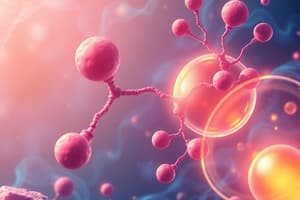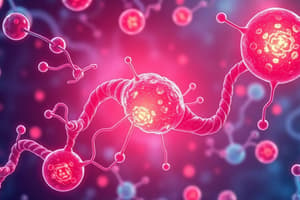Podcast
Questions and Answers
What is the role of ubiquitin in protein degradation?
What is the role of ubiquitin in protein degradation?
- It protects the protein from degradation.
- It transports amino acids into cells.
- It stabilizes the protein structure.
- It directs the protein to the proteasome for degradation. (correct)
Which of the following is a characteristic of proteins that are rapidly degraded?
Which of the following is a characteristic of proteins that are rapidly degraded?
- Having aspartate as the N-terminal residue. (correct)
- Being rich in hydrophobic amino acids.
- Being heavily glycosylated.
- Having serine as the N-terminal residue.
Which enzyme is responsible for cleaving N-terminal residues from oligopeptides in the small intestine?
Which enzyme is responsible for cleaving N-terminal residues from oligopeptides in the small intestine?
- Aminopeptidase (correct)
- Pepsin
- Carboxypeptidase
- Trypsin
Which condition is associated with immune-mediated damage to the small intestine upon ingestion of gluten?
Which condition is associated with immune-mediated damage to the small intestine upon ingestion of gluten?
Where does protein digestion begin in the human body?
Where does protein digestion begin in the human body?
What is the primary function of HCl in gastric juice during protein digestion?
What is the primary function of HCl in gastric juice during protein digestion?
What is the initial step in amino acid catabolism?
What is the initial step in amino acid catabolism?
How are free amino acids absorbed into enterocytes?
How are free amino acids absorbed into enterocytes?
What is the primary fate of urea after it is produced in the liver?
What is the primary fate of urea after it is produced in the liver?
Which of the following is the enzyme responsible for cleaving glutamine to produce glutamate and free ammonia in the liver?
Which of the following is the enzyme responsible for cleaving glutamine to produce glutamate and free ammonia in the liver?
Which of the following is a key function of aminotransferases?
Which of the following is a key function of aminotransferases?
Amino acids are obtained from which of the following sources?
Amino acids are obtained from which of the following sources?
Where does the urea cycle primarily take place?
Where does the urea cycle primarily take place?
Glutamate dehydrogenase (GD) is allosterically activated by which of the following?
Glutamate dehydrogenase (GD) is allosterically activated by which of the following?
When does amino acid oxidation increase substantially?
When does amino acid oxidation increase substantially?
In the glucose-alanine cycle, what is transported from the muscle to the liver?
In the glucose-alanine cycle, what is transported from the muscle to the liver?
In what forms does nitrogen leave the body?
In what forms does nitrogen leave the body?
Which of the following is NOT a source that supplies the amino acid pool?
Which of the following is NOT a source that supplies the amino acid pool?
Which of the following molecules provides one of the nitrogen atoms used in the urea cycle?
Which of the following molecules provides one of the nitrogen atoms used in the urea cycle?
Elevated plasma levels of alanine aminotransferase (ALT) and aspartate aminotransferase (AST) typically indicate damage to which organ?
Elevated plasma levels of alanine aminotransferase (ALT) and aspartate aminotransferase (AST) typically indicate damage to which organ?
What happens in the body of a healthy adult when nitrogen ingestion equals nitrogen excretion?
What happens in the body of a healthy adult when nitrogen ingestion equals nitrogen excretion?
What is the relationship between nitrogen ingestion and excretion in individuals experiencing a positive nitrogen balance?
What is the relationship between nitrogen ingestion and excretion in individuals experiencing a positive nitrogen balance?
Which scenario results in a negative nitrogen balance?
Which scenario results in a negative nitrogen balance?
During fasting, what is a major carbon source for glucose production by the liver?
During fasting, what is a major carbon source for glucose production by the liver?
In a healthy adult, what is the relationship between protein synthesis and degradation?
In a healthy adult, what is the relationship between protein synthesis and degradation?
What happens to urea excretion during the initial stages of fasting?
What happens to urea excretion during the initial stages of fasting?
What is the primary reason ammonia levels in the blood are kept low?
What is the primary reason ammonia levels in the blood are kept low?
Which organ plays a central role in removing blood ammonia?
Which organ plays a central role in removing blood ammonia?
What is the most important disposal route for ammonia?
What is the most important disposal route for ammonia?
In which organ does the formation of urea primarily occur?
In which organ does the formation of urea primarily occur?
What is a nontoxic storage and transport form of ammonia?
What is a nontoxic storage and transport form of ammonia?
Where does ammonia generation from glutamine occur?
Where does ammonia generation from glutamine occur?
Flashcards
Amino Acid Sources
Amino Acid Sources
Amino acids are obtained from diet, de novo synthesis, or protein degradation, and are not stored.
Amino Acid Degradation
Amino Acid Degradation
Excess amino acids are broken down and used for energy, especially when glucose and fatty acids are scarce.
Nitrogen Metabolism
Nitrogen Metabolism
The metabolism of nitrogen-containing molecules in the body, where nitrogen enters through diet and exits as urea, ammonia, etc.
Amino Acid Pool
Amino Acid Pool
Signup and view all the flashcards
Amino Acid Pool uses
Amino Acid Pool uses
Signup and view all the flashcards
Nitrogen Balance
Nitrogen Balance
Signup and view all the flashcards
Positive Nitrogen Balance
Positive Nitrogen Balance
Signup and view all the flashcards
Protein Turnover
Protein Turnover
Signup and view all the flashcards
Ubiquitin-Proteasome Pathway
Ubiquitin-Proteasome Pathway
Signup and view all the flashcards
Ubiquitin
Ubiquitin
Signup and view all the flashcards
Proteasome
Proteasome
Signup and view all the flashcards
N-Terminal Rule
N-Terminal Rule
Signup and view all the flashcards
PEST Sequences
PEST Sequences
Signup and view all the flashcards
Proteolytic Enzymes
Proteolytic Enzymes
Signup and view all the flashcards
Aminopeptidase
Aminopeptidase
Signup and view all the flashcards
Transamination
Transamination
Signup and view all the flashcards
Aminotransferases
Aminotransferases
Signup and view all the flashcards
ALT and AST
ALT and AST
Signup and view all the flashcards
Oxidative Deamination
Oxidative Deamination
Signup and view all the flashcards
Glutamate Dehydrogenase (GD)
Glutamate Dehydrogenase (GD)
Signup and view all the flashcards
Glutamine Synthetase
Glutamine Synthetase
Signup and view all the flashcards
Alanine's Role in Ammonia Transport
Alanine's Role in Ammonia Transport
Signup and view all the flashcards
Urea Cycle
Urea Cycle
Signup and view all the flashcards
Ammonia Elimination
Ammonia Elimination
Signup and view all the flashcards
Hyperammonemia in Kidney Failure
Hyperammonemia in Kidney Failure
Signup and view all the flashcards
Urea Production During Fasting
Urea Production During Fasting
Signup and view all the flashcards
Why Keep Ammonia Levels Low?
Why Keep Ammonia Levels Low?
Signup and view all the flashcards
Sources of Ammonia
Sources of Ammonia
Signup and view all the flashcards
Ammonia from Glutamine
Ammonia from Glutamine
Signup and view all the flashcards
Ammonia Transport
Ammonia Transport
Signup and view all the flashcards
Urea Formation (Ammonia Disposal)
Urea Formation (Ammonia Disposal)
Signup and view all the flashcards
Study Notes
- Protein and amino acid metabolism
Amino Acid Metabolism
- Amino acids are not stored in the body
- Amino acids are obtained through diet, synthesized de novo, or from normal protein degradation
- Excess amino acids are rapidly degraded
- Amino acid oxidation can provide energy in addition to glucose and fatty acids
- Amino acid oxidation as energy increases with excessive dietary protein or during starvation/disease
Nitrogen Metabolism
- Amino acid catabolism is part of the metabolism of nitrogen-containing molecules
- Nitrogen enters the body in food compounds, mainly amino acids in dietary protein
- Nitrogen leaves the body as urea, ammonia, and other products from amino acid metabolism
- The transformation of body proteins involves the amino acid pool and protein turnover
Amino Acid Pool
- The amino acid pool is supplied by body protein degradation, dietary protein (essential amino acids), and synthesis of nonessential amino acids
- The amino pool is depleted by body protein synthesis, consumption as a precursor of N-containing small molecules, conversion to glucose, glycogen, fatty acids, ketone bodies, CO2, and H2O
Nitrogen Balance
- In healthy, well-fed adults, the amount of amino acids in the pool is constant, that ingested N equals excreted N and that synthesis equals degradation
- Positive nitrogen balance occurs in babies, children, pregnancy, and individuals recovering from illness, where N ingested exceeds N excreted and synthesis exceeds degradation
- Negative nitrogen balance can occur with a lack of essential amino acids, fasting, starvation, malnutrition, and metabolic stress and is categorized by larger excretion than ingestion and catabolism greater than synthesis
Protein Turnover
- Proteins are constantly being synthesized and degraded, the total amount remains constant because synthesis replaces degraded proteins
- The rate of protein turnover varies among individuals
Protein Turnover: Degradation
- Protein degradation occurs via the ubiquitin-proteasome proteolytic pathway
- Proteins covalently attached to ubiquitin (a small, globular non-enzymic protein)
- The consecutive addition of ubiquitin moieties generates polyubiquitin
- Polyubiquitin is recognized by proteasomes
- Proteins unfold, deubiquitinate, cutting into fragments and eventually single amino acids, which then enter the pool
Protein Turnover: Signals
- Proteins chemically altered by oxidation/ubiquitin are preferred for degradation
- The half-life of a protein is influenced by the nature of the N-terminal residue
- Serine as N-terminal is long-lived with a half-life greater than 20 hours
- Aspartate as N-terminal has a half-life of 3 minutes
- PEST (proline, glutamate, serine, threonine)-rich sequence: rapidly degraded
Digestion of Dietary Proteins
- Most nitrogen in the diet is consumed as protein
- Proteins are too large to be absorbed by the intestine (except antibodies from breast milk) and proteins are metabolized to di- or tripeptides and amino acids
- Proteolytic enzymes are produced from different organs including the stomach, pancreas, and small intestine
Organ Specific Digestion
- The stomach secretes gastric juice containing HCl+ pepsinogen
- The pancreas secretes pancreatic enzymes and pancreatic secretion deficiencies can cause steatorrhea and undigested protein in feces
- The small intestine contains aminopeptidase (exopeptidase) in the luminal surface, cleaves N-terminal residues of oligopeptides to produce smaller peptides and free amino acids
- Celiac disease can cause immune-mediated damage to the small intestine in response to the ingestion of gluten found in barley, wheat, and rye
Absorption of Amino Acids and Small Peptides
- Free amino acids enter enterocytes through a sodium-linked secondary transport system of the apical membrane
- Di- and tripeptides are hydrolyzed in the cytosol to amino acids before entering the portal system by facilitated diffusion
Removal of Nitrogen from Amino Acids
- Alpha-amino groups keep amino acids from oxidative breakdown
- Removing the alpha-amino group is obligatory in amino acids that are catabolising
- Once removed, nitrogen can be incorporated into other compounds or excreted
Transamination
- Transamination transfers alpha-amino groups to alpha-ketoglutarate
- The reaction is catalyzed by aminotransferase, found in cytosol and mitochondria, liver, kidney, intestine, and muscle, and uses pyridoxal phosphate as a cofactor
- The product is alpha-ketoacid derived from the original amino acid and glutamate, which then undergoes oxidative deamination
- It is a reversible process involved in the degradation and synthesis of amino acids
- All amino acids except lysine and threonine participate at some point in their catabolism
Aminotransferase: Liver Disease
- Reactions are catalyzed during amino acid catabolism. A. Alanine aminotransferase (ALT). B. Aspartate aminotransferase (AST).
- Alanineaminotransferase (ALT)
- Aspartateaminotransferase (AST)
- Plasma AST and ALT are elevated in the case of liver disease
- In nonhepatic instances of disease, myocardial infarctions and muscle disorders may occur
Oxidative Deamination
- Oxidative deamination is the oxidative removal of the amino group from amino acids, resulting in ketoacids and ammonia
- Reactions occur in the liver and kidney, catalyzed by: Glutamate dehydrogenase (GD)
- The coenzyme is NAD+ or NADP+ and has allosteric regulators
- GTP: allosteric inhibitors of GD, ADP: allosteric activators of GD, when ATP decreases, amino acid degradation by GD increases
Transport of Ammonia
- The first mechanism involves most tissues, ammonia is used with glutamine synthetase to combine with glutamate to form glutamine, which is transported in the blood to the liver
- Once at the liver, glutamine is cleaved by glutaminase to produce glutamate and free NH3
- The second mechanism is for muscle
- It involves transamination of pyruvate to alanine
- Alanine is transported by blood to the Liver, then the pathway of gluconeogenesis is able to synthesize glucose (glucose-alanine cycle)
Urea Cycle
- Urea is the major form of amino group derived from amino acids, accounting for 90% of N-containing components of urine
- A urea molecule consists of 2 nitrogen atoms and 1 carbon and oxygen, and it is produced in the liver, then transported in the blood to the kidneys for excretion in the urine
Fates of Urea
- Urea diffuses from the liver and is transported in the blood to the kidneys-excreted in urine
- Urea can diffuse from the blood into the intestine, is cleaved to CO2 + NH3 by bacterial urease, and ammonia is then partly lost in the feces or reabsorbed into the blood
- Hyperammonaemia in kidney failure is characterized by elevated plasma urea levels, higher amounts of urea in the gut, and greater urease activity
- Treatment: Neomycin can cause decreased intestinal bacteria, and thus decreased ammonia
Fasting
- During fasting, the liver maintains blood glucose levels by utilizing amino acids from muscle protein that are a major carbon source for the production of glucose, or gluconeogenesis
- As amino acid carbons are converted to glucose, the nitrogens are converted to urea, and urinary excretion of urea is elevated as a result
- As fasting progresses, ketone bodies allow the brain to use ketone bodies and spare blood glucose
- Less muscle protein is cleaved to provide amino acids for gluconeogenesis, there is decreased production of glucose from amino acids is accompanied by decreased production of urea
Metabolism of Ammonia
- Ammonia levels must be kept low because hyperammonemia is toxic to the central nervous system
- There must be a metabolic mechanism by which nitrogen is moved from peripheral tissue to the liver and converted to urea, this occurs while maintaining the low levels of circulating ammonia
Sources of Ammonia
- Glutamine
- Bacterial action in intestine
- Amines
- Purine and pyrimidines
Additional Sources of Ammonia
- Ammonia is generated from glutamine by kidney/renal and intestinal glutaminase and glutamate dehydrogenase and it is excreted in urine as NH4+
- Bacterial urease in the lumen of the intestine
- Diet and hormones and neurotransmitter monoamines, from amine oxidase
- Catabolism of purines and pyrimidines is released when the amino group attached to the rings
Transport of Ammonia in Circulation
- Ammonia is constantly produced in tissues and is present at very low levels in blood
- Rapid removal of blood ammonia by the liver, and tissues including muscle, release amino acid nitrogen in form of glutamine or alanine, rather than free ammonia
Ammonia Transport Methods
- Urea is produced in the liver, is the disposal route for ammonia, and is created from liver→kidney→urine
- Glutamine is nontoxic, occurs primarily in muscle and liver, important for removal of ammonia in the brain, plasma concentrations are higher than other amino acids, is removed by liver and kidney, and deaminated by glutaminase,
Hyperammonemia
- Hyperammonemia is neurotoxic on the central nervous system
- Serum ammonia levels range from (5-35 M), elevated levels can cause tremors, slurring of speech, somnolence (sleepy, drowsy), vomiting, cerebral oedema, and blurring of vision, high concentrations can cause coma and death
- This occurs in acquired instances, such as liver disease (viral hepatitis) and hereditary conditions, such as ornithine transcarbamoylase deficiency (X-linked) and arginase deficiency
- Treatment includes the restriction of dietary protein and/or administration of phenylbutyrate
- Phenylbutyrate is converted to phenylacetate, which combines with glutamine to form phenylacetylglutamine, containing two atoms of nitrogen and causing excretion through urination.
Studying That Suits You
Use AI to generate personalized quizzes and flashcards to suit your learning preferences.




